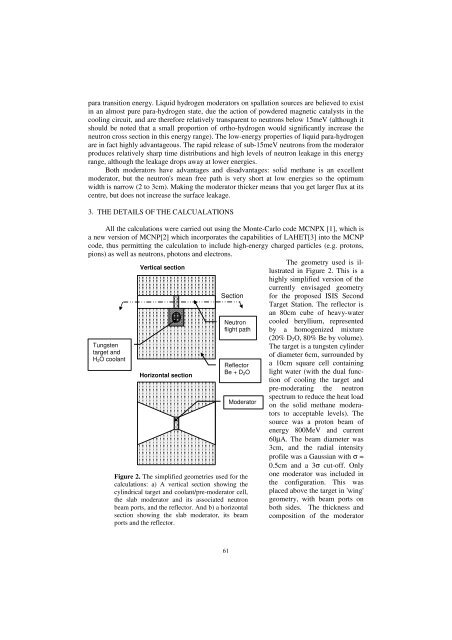Druck-Materie 20b.qxd - JUWEL - Forschungszentrum Jülich
Druck-Materie 20b.qxd - JUWEL - Forschungszentrum Jülich
Druck-Materie 20b.qxd - JUWEL - Forschungszentrum Jülich
Create successful ePaper yourself
Turn your PDF publications into a flip-book with our unique Google optimized e-Paper software.
para transition energy. Liquid hydrogen moderators on spallation sources are believed to exist<br />
in an almost pure para-hydrogen state, due the action of powdered magnetic catalysts in the<br />
cooling circuit, and are therefore relatively transparent to neutrons below 15meV (although it<br />
should be noted that a small proportion of ortho-hydrogen would significantly increase the<br />
neutron cross section in this energy range). The low-energy properties of liquid para-hydrogen<br />
are in fact highly advantageous. The rapid release of sub-15meV neutrons from the moderator<br />
produces relatively sharp time distributions and high levels of neutron leakage in this energy<br />
range, although the leakage drops away at lower energies.<br />
Both moderators have advantages and disadvantages: solid methane is an excellent<br />
moderator, but the neutron's mean free path is very short at low energies so the optimum<br />
width is narrow (2 to 3cm). Making the moderator thicker means that you get larger flux at its<br />
centre, but does not increase the surface leakage.<br />
3. THE DETAILS OF THE CALCUALATIONS<br />
All the calculations were carried out using the Monte-Carlo code MCNPX [1], which is<br />
a new version of MCNP[2] which incorporates the capabilities of LAHET[3] into the MCNP<br />
code, thus permitting the calculation to include high-energy charged particles (e.g. protons,<br />
pions) as well as neutrons, photons and electrons.<br />
Tungsten<br />
target and<br />
H2O coolant<br />
Vertical section<br />
Horizontal section<br />
Section<br />
Neutron<br />
flight path<br />
Reflector<br />
Be + D2O<br />
Figure 2. The simplified geometries used for the<br />
calculations: a) A vertical section showing the<br />
cylindrical target and coolant/pre-moderator cell,<br />
the slab moderator and its associated neutron<br />
beam ports, and the reflector. And b) a horizontal<br />
section showing the slab moderator, its beam<br />
ports and the reflector.<br />
61<br />
Moderator<br />
The geometry used is illustrated<br />
in Figure 2. This is a<br />
highly simplified version of the<br />
currently envisaged geometry<br />
for the proposed ISIS Second<br />
Target Station. The reflector is<br />
an 80cm cube of heavy-water<br />
cooled beryllium, represented<br />
by a homogenized mixture<br />
(20% D2O, 80% Be by volume).<br />
The target is a tungsten cylinder<br />
of diameter 6cm, surrounded by<br />
a 10cm square cell containing<br />
light water (with the dual function<br />
of cooling the target and<br />
pre-moderating the neutron<br />
spectrum to reduce the heat load<br />
on the solid methane moderators<br />
to acceptable levels). The<br />
source was a proton beam of<br />
energy 800MeV and current<br />
60µA. The beam diameter was<br />
3cm, and the radial intensity<br />
profile was a Gaussian with σ =<br />
0.5cm and a 3σ cut-off. Only<br />
one moderator was included in<br />
the configuration. This was<br />
placed above the target in 'wing'<br />
geometry, with beam ports on<br />
both sides. The thickness and<br />
composition of the moderator

















